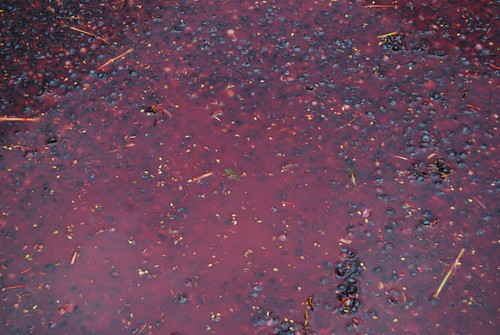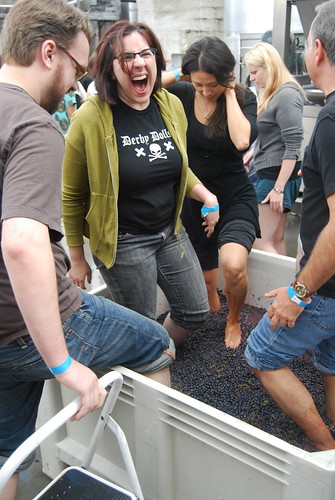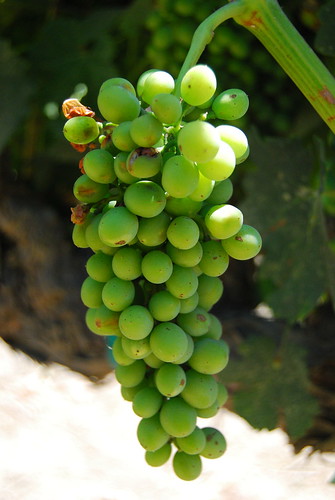time before you know if you've made a lovely bottle of elegant, sophisticated wine, or bottled what can only be described as vile grape juice with a hint of latex paint.
Six months after ordering a starter's kit, I poured my first fully aged, ruby red glass of Sherwin-Williams #7600, known to the layperson as "Bolero."
"This isn't bad!" I said to Lauren, coughing and trying not to get throat cancer.
After thoroughly reading the directions, an activity to which I was unaccustomed, I began. The good people at EC Kraus sent "First Steps in Winemaking" by C.J.J. Berry, who apparently lived in an English cottage surrounded by only glass carboys, rotting fruit, and his moustache. I read it quickly, glossing over recipes for elderberry wines and other assorted things that didn't seem germane to the task at hand. I learned about musts and hydrometers and sugar and how evil fruit flies are and how easy this was going to be. My days of Two Buck Chuck and crying myself to sleep would soon be halfway over.
After buying five pounds of sugar (four white and one brown - already pushing the envelope), I started up. I cleaned the equipment fastidiously, making sure to keep the dogs mostly out of the bucket and concentrate. The recipe called for one can of concentrate to thirteen cans of water. Looking back, I should have bought some distilled water from my local food library, but I was young and uninformed back then, and also I don't think water poured from the Holy Grail could have helped this dime store disgrace of a concentrate. After I mixed up the purple haze of ingredients, I added yeast nutrient, acid blend, and tannins, each with the utmost care and diligence I could muster.
There are as many kinds of yeast as one would expect, and wine is finicky about which yeast she allows into her matrimonial chamber. But the can of
SunCal concentrate spoke a name, and that name was Montrachet.
In somewhat unromantic terms,
Homebrewheaven.com has this to say about The 'Chet.
"Red Star® Montrachet (Davis 522), a strain of Saccharomyces cerevisiae, has been derived from the collection of the University of California. This strain has been widely used in the U.S. since 1963. It is a strong fermenter with good ethanol tolerance, and will readily ferment grape musts and fruit juices to dryness. This strain also has good tolerance to free sulfur dioxide. This strain is recommended for full bodied reds and whites. It is not recommended for grapes that have recently been dusted with sulfur, because of a tendency to produce hydrogen sulfide in the presence of higher concentrations of sulfur compounds. Montrachet is noted for low volatile acidity, good flavor complexity, and intense color. Certified kosher."
It was meant to be, as I was noted for my tendency to produce hydrogen sulfide in high school, and was in fact voted "Most Likely Not to Fight Acid" senior year. Go
Bearcats!
So I dumped the yeast into the must (as we in the business call it), fitted the lid and airlock on, and awaited my soon to be homemade Chateau
Latour.
The next day, the whole house smelled like vinegar, to Lauren's utter delight.
"Could you please make more wine? If only this smell would last forever!" I noted the sarcasm in her voice, but I paid it no mind. To me, that smell that reminded me of my grandmother washing her windows and of the stop bath I dunked countless black and white prints into during college. Now, and forever, that smell would remind me of hard work and something that I created myself and could torture my friends and family with.
A week later, after the violent discharge of carbon dioxide slowed, it was time to "rack" the wine off the sediment. As the yeast eats the sugar and converts it into alcohol, it throws off sediment and CO2, which I suppose is a nice way of saying that it poops out grit and farts out carbon dioxide. It's good work if you can get it.
The bucket that came with my hundred dollar kit included a very handy spigot at the bottom, which made racking easy and fun! All I had to do was hook the spigot to a tube, then lead that tube into a secondary
fermentor, which in this case was a bladder-like plastic jug that I added to my order for only $12.00. After I had rinsed out all the gunk from the bottom of the bucket, I poured the wine back in, and sealed 'er back up so the yeast could finish its dirty business.
Three weeks later, my blue
bordeaux bottles and gold
heatshrink seals had arrived, and I was ready to bottle. I'll spare you the particulars of my clumsiness, but let's just say that the
countertop and floor around where I was bottling were slurring their speech and they both had to crash on the couch for the night. I still didn't quite have the hang of the heat shrinks, which involves rubber banding one of those fancy foil things over the cork and dipping it into boiling water. That also did not go well, leading to some boiling water on my trousers, a couple of snapped rubber bands, and some really crappy looking bottles.
But I was finished.
I poured myself a glass, with the sensation of heat running up the back of my neck, like I was about to some public speaking. I was actually, really, physically, nervous.
As I tasted it, I realized two things: one, I was not blind, and every hillbilly movie I ever saw learned me that if you don't go blind after drinking, then the stuff is fine. Secondly, the wine tasted terrible.
"It says two to four months of aging, Lauren. That must be it. It's just not ready yet," I said. The full impact of those words didn't sink in for a few minutes. "Is it that
the wine isn't ready for us," I thought. "Or are we not ready for the wine?" It turns out that we are mutually unready for each other.
"This tastes like
Manishevitz," Lauren said, unaware of the psychic gashes her crazy Yiddish words were inflicting on my mind.
"I don't know what that is," I replied, in my usual manner.
"It's wine. We have it at Passover."
With me being a good Catholic boy, all these words just turn into a jumble.
"Thanks?"
"I'm sure it'll be better after it's aged."
Famous Last Words.
About two months later, our friends Jeremy and Marissa had their wine tasting party, which I've come to look forward to eagerly each year, not only for their company, but for these amazing little sandwiches that Marissa makes.
Seriously, the sandwiches are awesome. I cannot overstate this. Awesome.
The theme that night was "The Wines of Italy," as Jeremy and Marissa had just returned from Italy, and doubtlessly wanted to fix the results of the tasting in their favor. It was a dastardly plot, but a kid from Jolly, Texas, with only the shirt on his back and a dream of some day making a drinkable wine, had other plans. (Talking about me here)
I brought a Chianti that had been in the cupboard for quite awhile as my fake-out entry, designed somewhat cunningly as a diversion. By introducing a wine made by actual people who actually knew what they were doing, I hoped to confuse and disorient the party, splitting the vote and handing the
Huevos Caballos '07
Pinot the crown. It was a Rove-
ian gambit, I admit, but one I assured myself would pay off in the long run, earning me that door prize.
I
snuck the
Huevos Caballos in next to the Chianti, which was already generating a fair amount of buzz (in my mind). Marissa and Paris, another friend, covered the wines in brown paper, along with the wines the others brought, so as to make the blind tasting as fair as possible. I snickered as they walked past, my confidence growing like yeast in a stable, 77 degree, high sugar environment.
Like the yeast, I needed to be taken down a peg.
I could tell by the feeling in the room (and the top of the bottle, and the way that it made the whole apartment smell like paint) that it was
Huevos time. as Marissa poured everyone their tasting glass, I leaned back in my chair.
"This smells like paint," Brian said. He was an actor, and at that moment, I vowed never to hire him again.
"What are you talking about?" I said nervously. "This smells great."
I took a sip, careful not to betray the wine corroding my larynx.
"You know what this tastes like?" Jeremy said, as he looked at me. "It tastes like love. This tastes like someone slaved over it and nurtured it, and that every drop of that emotion is in this glass of wine."
"That's a very good observation," said I, trying to hide the tears welling up in my eyes, which were caused partly by the wine's odor, partly because my friend had
sommaliered the shit out of everyone there.
"No, this tastes like paint."
My ringer Chianti didn't fare well, scoring (much deservedly) toward the middle of the pack. No wine stood out, at least in terms of traditional "quality," that night. I hoped that Jeremy's rousing speech would be enough to send me and my paint juice over the line.
"And the winner is...number three!" Paris said. I whipped my head around. Marissa was cutting off the brown paper covering the label of the winner. A thin sheet of recycled pulp was all that stood between us and our destiny. As she tore, I saw a white label corner peek through.
Then an "H."
Then a "U."






.jpg)








